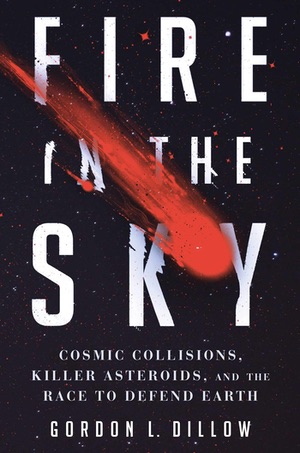Review: Fire in the Skyby Jeff Foust
|
| “The chances that an asteroid or comet of potentially catastrophic size will come hurtling toward Earth are exactly 1-in-1,” writes Dillow. “The only variable is when.” |
Dillow got interested in the subject when he witnessed a collision on a far smaller scale: a meteor he saw in the pre-dawn hours of June 2, 2016, above his Arizona home, which turned out to be an asteroid close to two meters across releasing the equivalent of a half-kiloton of TNT. That fireball created a brief blip in the news, but stimulated his interest in the topic to the point that he decided to write a book about it, even though he knew little about the subject prior to that early morning flash.
What follows is a good introduction to the topic, one that will be familiar to those who already know about Chicxulub and Chelyabinsk. There’s a heavy historical bent to much of the book, following the efforts of Daniel Barringer at the turn of the 20th century to search (unsuccessfully) for the meteorite remnant of the object that created Meteor Crater, and later work by Gene Shoemaker to prove that it was indeed an impact that created the crater. There’s also the father-son team of Luis and Walter Alvarez, who discovered the layer of iridium-rich material at the K-T boundary and argued it was created by an asteroid impact that wiped out the dinosaurs and many other forms of life 65 million years ago. These are as much character studies as historical accounts of the science, bringing to life these individuals.
There’s later an examination of more recent events, like the Chelyabinsk event and efforts to search for, and plan for impacts by, near Earth objects, encapsulated under the term “planetary defense.” He spends a night with one astronomer at an Arizona observatory looking for near Earth asteroids, and follows asteroid impact planning exercises done by interagency groups and astronomers. (Noting that in two past exercises that simulated impacts took place in Pasadena, Texas, and Pasadena, California, he speculated that a similar exercise scheduled for this spring at a conference outside Washington, DC, would target Pasadena, Maryland. Instead, like a bad sci-fi movie, the asteroid hit New York.)
| As his book argues, there’s much more to do to avert such an impact, but the good news is that we’re better aware of, and prepared for, the threat than ever. |
Dillow argues that governments like the US need to spend more on searching for, studying, and preparing to deal with potentially hazardous asteroids. (He adds that companies like Planetary Resources and Deep Space Industries could be a “huge help” with that, unaware that both companies have been acquired and appear to have abandoned the asteroid mining ambitions.) What he doesn’t say, though, is just how much more money should go to planetary defense. NASA’s spending on the field has soared in the last decade, from a just a few million a year to support observing efforts to $150 million in its current budget, which also funds development of a mission called DART (Double Asteroid Redirection Test) to test how a kinetic impactor could shift the orbit of a threatening asteroid. That funding level looks to be stable for at least the next few years, and could support development of other missions in the years to come, like the NEOCam observatory to search for near Earth asteroids. Yes, asteroids pose a threat to the Earth, but so do other phenomena that have more certain near-term effects, like climate change. What is the best use of resources?
Dillow is correct that, sooner or later, a large asteroid or comet will pose an impact risk to the Earth, even though for now no such object threatens to collide with the Earth for decades despite the histrionic headlines in the tabloids. As his book argues, there’s much more to do to avert such an impact, but the good news is that we’re better aware of, and prepared for, the threat than ever.
Note: we are temporarily moderating all comments subcommitted to deal with a surge in spam.
